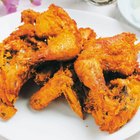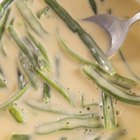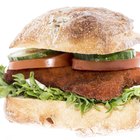
While you certainly can eat deep-fried foods the day after you make them, the quality will not be nearly as good as if you are eating them freshly cooked. The crunchy coating of most fried items deteriorates in the refrigerator, becoming soggy. A few tricks will help keep the coating crispy.
Fried Food Basics
Fried foods fall into two categories: breaded and battered. Breaded foods are made by dredging meats and vegetables in flour to create a thick coating. This breading can be made thicker by double-dredging the food in flour, using an egg or buttermilk wash in between so more flour sticks to the food. Battered fried foods are made by mixing flour and a carbonated beverage, like sparkling water or beer, to create a thin batter that food is dipped in before being submerged in oil. Both battered and breaded foods are cooked in oil that is heated to 350 degrees Fahrenheit.
Storing Deep-Fried Foods
Deep-fried foods tend to lose their crunch when you put them in the refrigerator. Most fried food falls into the perishable category and needs to be refrigerated within two hours of cooking to prevent the growth of harmful bacteria. To keep fried foods crisp, drain as much oil as you can from the foods. Store fried foods in an airtight container on a paper towel to help soak up any excess oil. Do not put fried foods in the refrigerator before they are completely cooled, as the condensation will make the coating soggy.
Reheating Deep-Fried Foods
When you are planning on serving deep-fried foods made the night before, don't use the microwave to reheat them. Instead, heat an oven or toaster oven to 400 F and reheat the fried food until the internal temperature registers at 165 F.
Fried Food Preparation Tips
While frying foods in advance is less than ideal, how you prepare your fried foods can save time when you are frying. If you are frying chicken, season it the night before and marinate it in buttermilk, then store it in the refrigerator until you are ready to cook it. Prepare the dredging flour and its seasonings in advance so you are ready to go when its time for frying. Many vegetables can be breaded in advance and stored in the refrigerator, leaving you just the step of frying the foods.
Related Articles

Deep-Frying Using All-Purpose Flour

Can You Substitute Anything for Egg Dip ...

How to Make Breading Stick to Meat ...

Can You Deep-Fry Frozen Uncooked Shrimp?

How to Fry With Bread Crumbs

How to Make Teriyaki Sauce

How to Cook a Gizzard

How to Use Panko

Lumpia vs. Egg Rolls

How to Cook With Coconut Flour for Main ...

Frying With Flour, Eggs and Bread Crumbs

How to Fry Using Wet Batter

How to Cook With Stainless-Steel Frying ...

Freeze-Ahead Meals With Pork Chops

Can You Cook Frozen Foods That Are Past ...

List of Cuban Foods

How to Cook Chicken Schnitzel

What Are the Best Containers to Freeze ...

Breading With Baking Soda and Flour for ...

How to Cook Fried Drummettes
References
Resources
Writer Bio
Based in Portland, Ore., Maxine Wallace is a writer with more than 12 years of experience. With a bachelor's degree in journalism and experience working on marketing campaigns for large media agencies, she is well-versed in multiple industries including the Internet, cooking, gardening, health, fitness, travel and holistic living.
Photo Credits
Medioimages/Photodisc/Photodisc/Getty Images